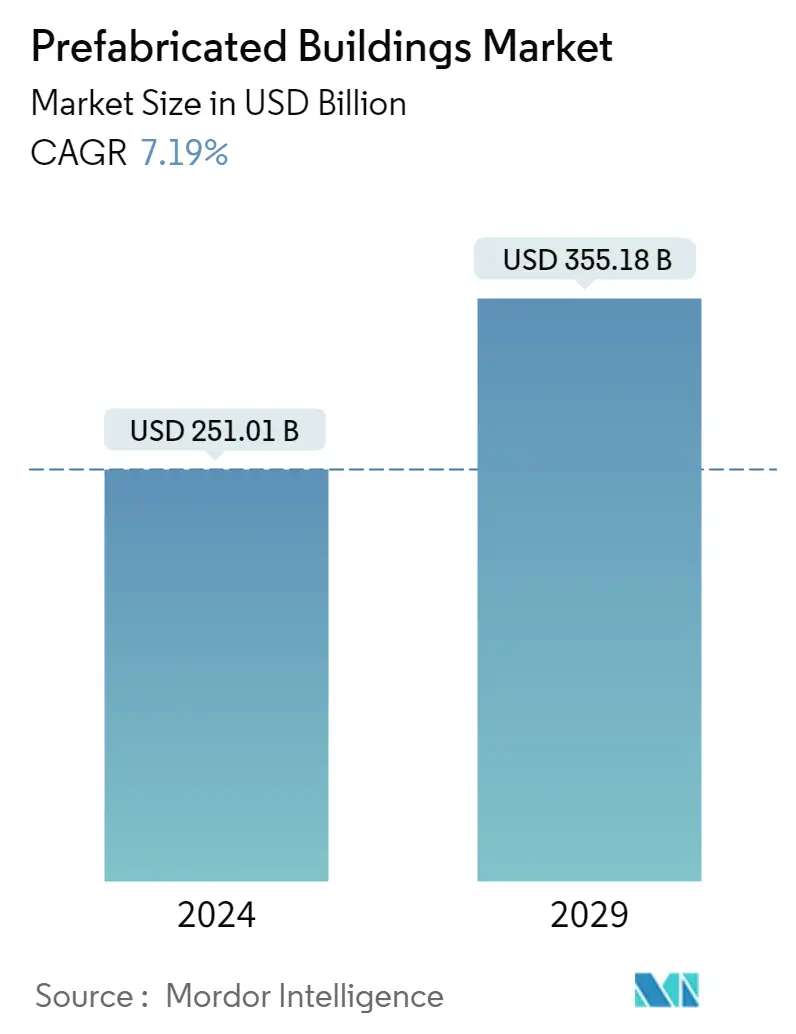Market Size of Prefabricated Buildings Industry

| Study Period | 2020 - 2029 |
| Market Size (2024) | USD 251.01 Billion |
| Market Size (2029) | USD 355.18 Billion |
| CAGR (2024 - 2029) | 7.19 % |
| Fastest Growing Market | Asia-Pacific |
| Largest Market | North America |
Major Players
*Disclaimer: Major Players sorted in no particular order |
Need a report that reflects how COVID-19 has impacted this market and its growth?
Prefabricated Buildings Market Analysis
The Prefabricated Buildings Market size is estimated at USD 251.01 billion in 2024, and is expected to reach USD 355.18 billion by 2029, growing at a CAGR of 7.19% during the forecast period (2024-2029).
All construction-related operations worldwide stopped due to the COVID-19 pandemic and consequent lockdowns. As a result, modular construction projects in various construction segments, such as educational, residential, airports, and others, had decreased, thus significantly impacting demand for prefabricated buildings. In several places, the supply chain had also been interrupted, thus causing a delay in the delivery of construction material required and affecting the construction activities.
The adoption of additive manufacturing in Europe is expected to significantly boost the prefabricated construction sector. Companies are embracing eco-friendly products and production practices to set themselves apart from the competition. The introduction of energy-absorbing materials such as micro dwellings resulted from the focus on energy efficiency.
Another major factor driving market expansion in the region, particularly in Switzerland, the Nordics, and the United Kingdom, is the introduction of turnkey solutions. Germany, the Nordic countries, and the United Kingdom dominate the prefabricated building industry in Europe.
The United Kingdom is a prospective market for prefabricated building companies. The major players are investing in improved performance and productivity to capitalize on the market's growth potential and modular construction approaches. The existing shortage of skilled labor in the construction industry is a crucial element sustaining the United Kingdom's position in the European prefabricated building industry.
Prefab enterprises have a huge opportunity in India, where there is a need for hundreds or thousands more plants in the future. India is anticipated to be among the fastest-growing countries in terms of construction output over the next few years, making technology a critical component.
India is projected to be the world's second-largest building market in the next five years. A continued government push for digitalization and the adoption of cutting-edge construction technology like BIM is a key driver for the adoption of prefabricated buildings. Government efforts such as "Digital India," "Housing for All," and "Bharatmala Pariyojana" have boosted the use of prefabricated buildings in India.
The value of prefabricated buildings imported into Spain increased significantly in 2022. From 2003 to 2007, the imports of these products increased until they were valued at EUR 101 million(USD 109.78 Million). After that, those imports had a downward trend, reaching EUR 36 million(USD 39.13 Million) in 2012. The prefabricated buildings imported in 2021 into Spain were valued at EUR 65 million(USD 70.65 Million).
